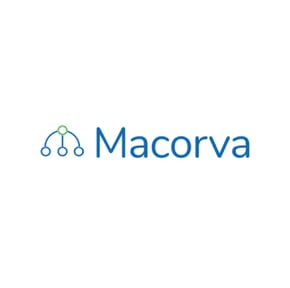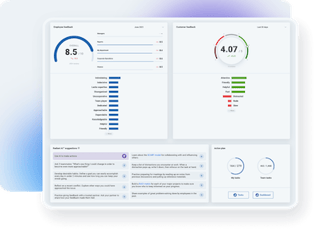
Step-by-Step Guide to Creating Effective Employee Onboarding Surveys
Why onboarding surveys and new employee feedback are crucial.
Imagine pouring months into recruiting the perfect hire, only to see them walk out within 90 days? That's the harsh reality for countless companies, with studies revealing an alarming 30% of employees leave within the first three months. Macorva’s data from working with clients across a broad industry spectrum indicates that the first three months of a new hire’s experience are the make or break for fulfilling employee satisfaction in the long run.
Jump to a specific topic in this blog via the links below:
Employee Churn in The First 90 days
Designing Effective Onboarding Surveys
Survey Customization
Anonymous Feedback
Recommended Questions
Why Optimizing Onboarding Experience Is Critical
Measuring and Assessing Survey Results
The Impact of Onboarding on Employee Engagement
Onboarding Best Practices
Okay, so two questions emerge immediately?
- What’s the impact on the bottom line of an employee turnstile spinning at such a fast rate?
- What’s driving its momentum?

Employee churn in the first 90 days - a severe challenge
c. Inept leadership
Future trends in onboarding require stakeholders to have their finger on the pulse of employees' feelings as they relate to work equilibrium. Resignation bubbles frequently lurk just below the surface in the onboarding stages. Detecting them before they explode unexpectedly makes all the difference in fostering employee retention.
b. Projects slow down due to team instability, not to mention the domino effect on other employees who are demotivated and frustrated by the downtime and deterioration in their KPIs for no fault of their own.
This London School of Economics report confirm that lower staff turnover reflects higher profitability while deflecting toxic employee dissatisfaction, weakened staff loyalty, and productivity drops. In summary, early terminations (voluntary or by firing) are not helpful to the business' ROI, employee morale, revenue growth, or reviews impacting the company's reputation for future hiring.
This brings us to the subjects of survey design, anonymous feedback, and employee survey software in logical order below.

Designing Effective Onboarding Surveys
Designing onboarding surveys requires a thoughtful, step-by-step process with penetrative questions unafraid of the feedback that may throw leadership or systems in a bad light. Indeed, launching a constructive onboarding experience without asking the right questions is like diving into a pool with shallow water. Coming out of it unblemished is unlikely.
Surveys in the first few weeks send a signal to new employees that their voice matters. It plays into an inclusive culture from the outset. Aside from that, the goal is setting one’s human resources up for success. The latter emerges from two primary sources:
- Qualitative Feedback - Insights into recruits' emotions, perceptions, and thoughts intermittently during the onboarding process.
- Quantitative Feedback - Metrics that measure onboarding trends (for example, how many recruits feel the same way), effectiveness in meeting job performance expectations (based on crucial KPIs) - any fact-based and measurable data.
Survey Customization
So, a generic survey with questions unrelated to the job, the employees' hierarchical standing, circumstances of employment, and perceived culture will appear insincere or lack credibility. It's not so much branding surveys as instead leveraging them to brand the company as being concerned, transparent, and connected to all the drivers employees rely on to be functional at work. Put another way, you want your surveys to create employee excitement in being part of the team.
Anonymous Feedback
In other words, anonymous surveys may be counteractive in onboarding where identity transparency works better. Why?
- Guessing which new hire said this or that won't help much to fix issues if the process is already derailing.
- Onboarding surveys are more part of the employee engagement process (versus taking a bird's eye view of the process functionality in a detached way, apart from the personalities involved).
- New hires may only be one or two people at a time, so there's no point in hiding comments emerging from a limited respondent pool.
Recommended Questions
The decision to join your company
Recruitment
- Would you consider the recruitment process to be a positive experience? [Rating scale]
- I was provided with sufficient information about {Company} during the recruitment period. [Rating scale]
- I was provided accurate information about {Company} and my role during the recruitment process. [Rating scale]
- Is there something we could have done to improve the recruitment process? [Free-response]
The decision to join your company
- Please indicate three reasons why you joined {Company}? [Free-response or select from outlined options}
- I was confident I made the right decision when {Company} offered me the position. [Rating scale]
- What can {Company} do to improve decision confidence and employee commitment during recruitment? [Free-response or select from outlined options]
- How important was the {Company} brand as an influence to come onboard? [Rating scale]
- What more can {Company} do to present itself positively to new hires? [Free-response]
The onboarding experience so far
- Have you received the help you needed? [Rating scale]
- The work environment at {Company} is what I expected. [Rating scale]
- What’s one thing we could have done differently to improve the first week of your onboarding experience? [Free-response]

Questions in Week 5
Induction
Company Alignment
Role Understanding
The category questions provided below are all score-centric. However, at the end of each set, it's helpful to add something like the following:
- “Considering your answers above, what would you do to improve {Category in question}? [Free-response]”
Employee engagement questions
- How likely are you to recommend working at {Company} to a friend or colleague? [Rating scale]
- I still think this is a great role for me. [Rating scale]
Questions about induction
New hire induction - knowing how enabled new hires feel about:
Their learning curve expectations versus reality
The training plan designed to get up to speed
Their manager’s leadership and mentorship abilities
Opportunities to integrate with the team
Consider the following:
- How comfortable do you feel with the technology and tools provided for your role? [Rating scale]
- How satisfied are you with the training and resources provided during onboarding? [Rating scale]
- I know what my job duties are and what I need to learn to perform well. [Rating scale]
- The information and instructions from my manager match what I expected for my job. [Rating scale]
- I feel welcome and part of the team. [Rating scale]
Questions about organizational alignment
- The organizational values of {Company} align well with my own personal values. [Rating scale]
- I understand how my role contributes to the organizational goals of {Company}. [Rating scale]
- My company experiences so far have been positive. [Rating scale]
Questions about role perceptions
In this category, you want to know if the job description aligns with their expectations, as follows:
- The job description {Company} provided me matches my team role. [Rating scale]
- How do you feel about your new role and responsibilities? [Rating scale]
Why Optimizing Onboarding Experience Is Critical
- Organizational backing to ensure things go as smoothly as possible.
- A board-level commitment to approve the necessary resource provision and budgets for onboarding success and optimization - a giant step in the right direction.
- Stakeholders in operations implementing approved strategies with discipline and forethought.

Measuring and Assessing Survey Results
Onboarding survey results are as helpful as a flat battery torch (and as enlightening) unless there's a disciplined program to assess the qualitative and quantitative feedback as scientifically as possible. To create understanding with the new hires, onboarding KPIs and success parameters around the metrics at different stages should be on the table for all relevant parties to know and understand.
Indeed, setting KPI expectations for new hires significantly reduces subjectivity in their evaluations, except when feedback suggests that performance issues stem from systemic problems within the onboarding process. That's another matter, re-emphasizing why formal appraisals of responses to questions (see above) are imperative.
Examples of leveraging KPIs are as follows:
- A recruited salesperson may have to interact with X number of new clients in a region by week {number} or meet with X of appointed loyal clients by {Date}.
- Management expects a digital marketing new hire to achieve a range of Google Ad KPIs defined by {X} clicks and {Z} conversions for eCommerce brands by {Date}.
The Impact of Onboarding on Employee Engagement
We’ve emphasized above that feedback analysis and regularly interacting with recruits lie at the core of continuous improvement to the point where the company and the employee feel the onboarding process is near its end. So, in a nutshell, onboarding and employee engagement go hand in hand. Of course, at that point, the integrated individuals should have a journey path ahead that connects to:
- Role clarity
- An established employee pride in their work
- The KPIs and feedback they’ve experienced while onboarding
Organizational alignment at its best involves a seamless and unforced transition in which stakeholder expectations and employee engagement parameters change significantly (but controllably) as time progresses.

Onboarding Best Practices
Establishing a schedule for distributing and reviewing employee lifecycle surveys is front and center of one’s survey design strategies. This ensures consistent data collection and timely analysis. Additionally, implementing protocols to keep surveys concise, focused, and non-intrusive to respondents is essential. Involving relevant teams, managers, and new hires in a structured manner promotes collaboration and ensures all voices are heard, leading to more effective surveys.
To reiterate the points underlined above on anonymous feedback (as one tactic); deciding between keeping responses anonymous or not should be used judiciously and only where a lack of ID inclusion may skew the results. To get the best perspectives and use different methods proficiently, we suggest relying on a platform that can streamline and simplify the feedback collection and analysis process like software offered by Macorva - a recognized leader in the EX marketplace. Why?
- Marcorva’s platform aligns with smoothing clients’ onboarding journeys and employee lifecycle management through sophisticated but surprisingly easy-to-use AI-driven tools that significantly accelerate the processes as outlined above.
- Our AI technologies embrace employee engagement, KPI monitoring, job satisfaction, and all the other drivers of a successful new hire’s EX at its core.
- Macorva clients universally commend these solutions as incredibly effective in removing the obstructive touchpoints that slow things down when going the old-fashioned route.
Engaging in a conversation with our team of EX experts will give insight on how our tailored AI solutions solve common onboarding challenges to boost employee engagement and drive growth.
Conclusion
Employee retention impacts revenue and overheads, making it a primary ROI influence modern businesses can't ignore. And where do successful employee loyalty programs begin? At the onboarding stage. The first two months of new hire engagement either puts the employee lifecycle on the right path to long-term tenure or propels it into the black hole we call premature termination.
For more information on how Macorva can enhance your EX onboarding strategy, consider exploring the following resources:





